
The
dry bulk market in 2001Has
the announced crisis happened? |
|
|
| |
While the year
2000 was a colour print, 2001 was the negative. We should not however be
surprised. The low prices for newbuildings, offered throughout 1999 and
even in 2000 by Far Eastern shipyards led to a plethora of orders.
Deliveries in the course of the year reached record levels of 6.6
million dwt for the Handysize (158 ships), 8.6 million dwt for the
Panamax (116 ships), and 5.8 million dwt for the Capesize (34 ships),
whilst at the same time the demolition figure was only 8.6 million dwt
for all sizes.
|
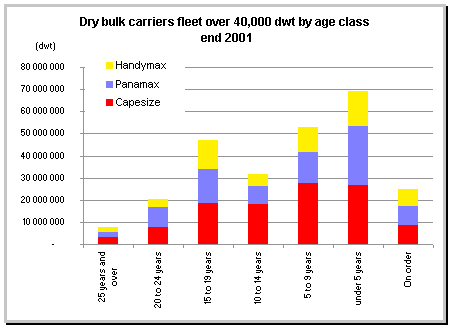
|
| The freights |
|
Already towards
the end of 2000 a slowdown could be felt, the Baltic Dry Index closing
at 1,600 points, below its maximum of 1,760 points reached in November,
and expectations were clearly bearish. However against all likelihood,
the market held up with mixed fortunes until the end of May when the
number of ships delivered started to weigh heavily. Exports of
Australian coal continued at a sustained rate to an extent that they
were able to absorb in the initial months the deliveries of new
Panamaxes.
|
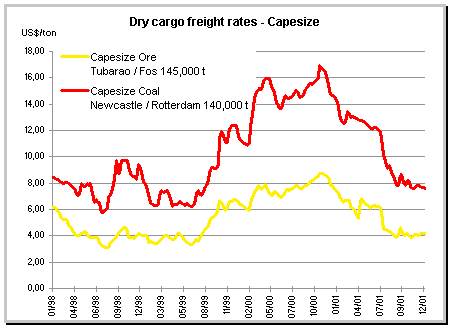
|
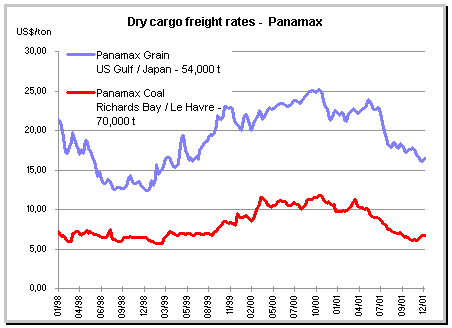
|
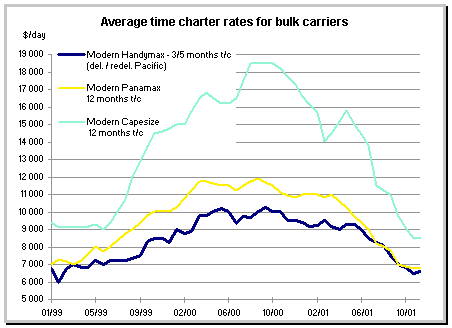
|
| Demand |
|
|
China started playing a more and more active
role in this sector, overtaking South Africa in second place as largest
coal exporter in the world. In the month of March alone, China exported
nearly 10 million tons of coal. On the other hand, right from the start
of the year, the demand of iron ore was in decline as compared to 2000
figures.
Although the Chapter 11 bankruptcy filing of a number of American
steel companies of which Bethlehem Steel is the most noteworthy had a
relatively small impact on the volume of ore transported by sea, the
world economic environment dictates the rules for steel operators.
According to the International Iron and Steel Institute, American
production in 2001 has dropped back by 10.9 % as compared to 2000.
Production in the E.U. was down by 2.7 % and the two heavyweights -
France and Germany- were respectively down by 7.7 % and 3.4 %. At the
same time India saw its production rise by 1.4 % and Japan's dropped
by 3.4 %, but Asia registered a combined production of 332 million tons
namely 4.0 % higher as compared to 2000. Once again China showed itself
to be a major player with production reaching 141 million tons.
In 2001 world crude steel production totalled 823.9 million tons
against 829.6 in 2000. Given the uncertainties in the international
scene, the result is remarkable.
In the light of these figures one is tempted to conclude maybe a
little hastily that the fall in freight rates was the result of an
excess of tonnage on offer. This impression needs to be tempered
somewhat. One of the highlights of this year was the merger, after that
of British Steel and Hoogovens in 1999, of Usinor, Aceralia and Arbed to
give birth to the number one steel company in the world with a
production capacity of 45 million tons. Other steel companies are
following as a merger between NKK and Kawasaki has been announced.
Whilst awaiting the outcome of the big merger, as well as doubts
about the world demand, an important volume of contractual cargoes was
not covered. Elsewhere the necessary adjustments to production and
stocks were done at the last minute, on a step by step basis as the
American economy slipped into recession, as Japan went deeper into its
stagnation, and with the slowing-down of activity in Germany.
Finally, suffering from a double monetary constraint and the high
freight rates of 2000, Japan and more especially China relocated their
ore supplies from Australia at the expense of Brazil, thus reducing the
volume in tonnes-miles transported. This situation prevailed right
throughout 2001.
Elsewhere world demand for coal, despite rising regularly, has also
seen some changes. As for ore, the Asian economies switched increasingly
to Australian or Chinese coal, at the expense of South Africa and
America. To illustrate this, in the first nine months of 2001 South
Africa exported 5.9 million tons towards Asia as compared to 11.8
million tons for the same period in 2000.
Steel companies have not been the only ones to merge. The Australian
mining company BHP and the South African Billiton have created one of
the biggest world groups. In the cement industry the merger between
Lafarge and Blue Circle has created the biggest world force in this
sector with a production of 14 million tons. The German Heidelberg
Cement with its purchase of Scancem are close on their heels. Grain
companies got into the act with the purchase of the American Continental
Grain by its compatriot Cargill in 1998. There are others who have been
left aside in this consolidation as can be witnessed by the bankruptcy
of the Swiss Andr'.
This process could not leave the shipowners totally indifferent.
Their response came quickly as already in November 2001 the English
ABC-Zodiac (ABC being already the product of a merger between
P&O/Shougang) and the Belgian Bocimar announced their union, giving
rise to the largest world Capesize owner with 80 ships (bearing in mind
that the total Capesize fleet is 656 ships). The creation of very large
Panamax or Handymax owners has not yet occurred, but it is true that
these markets are much more dispersed.
We are therefore seeing a globalisation of the market with a small
number of players but with increased influence. At the same time freight
has become a commodity like others that one can buy and sell spot and
term, giving birth to a new type of operator specialised in Capesize
and/or Panamax in certain geographical zones or trades, such as
SwissMarine or Enron (whose bankruptcy is only a blip in this
evolution). The recent period when a contract was wide open, now seems
something of the past. Nowadays for each charter, a dozen owners at
least (luckily not always the same) propose variations of a theme. In
this respect the growth in the market for buying and selling freight 'futures',
provides a host of possibilities for hedging or making other alternative
complex coverings.
The nearly instantaneous knowledge of ship's positions, the rapid
circulation and the abundance of information paradoxically can
complicate getting to the basic essentials. In order to remain in the
game, it is now more than ever crucial to be part of the initiated few.
It is true that after an euphoric 2000, 2001 pales in comparison and
the facts are there to back this up. However the rationalisation of the
market, which began several years ago, has quickly accelerated and only
a more positive economic situation will lead to improved freight
markets.
The strong players of the future are formed in these times of crisis.
Abundant, complex information requires specialists and also favours the
development of new tools for its analysis and interpretation, and only
the best armed will be able to survive.
|
 |
Lake Maine
53,500 dwt, grab-fitted blt 2001by Imabari Shipbuilding, owned by Daio Kaiun Ltd (Japan) and on long time charter to Louis Dreyfus Armateurs (France) |
|
| The
second-hand market |
|
| The
Capesize second-hand market (80,000 dwt and over) |
|
|
Last year we concluded our analysis by
stating that it would be necessary to be prudent in 2001. In practice
during the first quarter, the second-hand Capesize market continued to
follow its downward trend already begun at the end of 2000.
Values then flattened out between March and April. They rose strongly
up to the end of June when they literally collapsed until September,
before steadying out at a level well below last year's. One only needs
to look at the fluctuations in freight rates to find the reasons for
these dramatic variations in prices.
As always the oldest ships were the most affected, whereas modern
units tend to gain less in rising periods and lose less in falling ones.
There were some 26 sales for further trading (comprising 16 ships
delivered from 1990 to 2001 and 10 built between 1981 and 1989.) Eight
ships built between 1969 and 1978 were demolished this year amounting to
1,043,000 dwt, whilst 34 ships were delivered totalling 5,769,000 dwt.
For a fully classified ship and in good condition, the following
values were applicable:
January 2001 December 2001
150,000 dwt built in 1995 about $26 / 27 m about $18 / 19 m
150,000 dwt built in 1990 about $19.5 / 20 m about $14 / 14.5 m
The consolidation in the market, reinforced by the setting up of the
Cape International pool, does not prevent some strong crosswinds from
blow-ing. Even if at year's end it seems to be calmer with a slight
rise in the freight rates, the tendency for ship's values are
declining as there are big uncertainties within the world's economies.
Construction prices should not rise next year which will have a
direct repercussion on values of the most recent ships. In a poor
market, it is always preferable to renew one's fleet by a newbuilding
rather than by acquiring a modern second-hand ship with immediate
availability.
The drop in the yen if it continues its path pursued at the end of
the year, should incite Japanese sellers to be more flexible on asking
prices for their ships financed locally. Values expressed in dollars
should therefore suffer.
It will take a real and solid recovery in freight rates together with
a renewed revival in growth prospects for second-hand values to be able
to move up substantially. If the hopes are less muted at the end of the
year, the reality remains stubbornly subdued even if in a thin market
like the Capesize, changes in situations can sometimes be quicker than
expected.
A glimmer of hope lies in the current modest orderbook. It represents
about 9.3 % of the existing fleet. In 2002 only 25 ships should be
delivered by shipbuilding yards for a total capacity of 4.2 million dwt.
|
| The
Panamax, Handymax & Handysize second-hand market |
|
|
At the end of last year, we concluded our
review for this segment of the sale & purchase bulk carrier market
saying that players in the shipping industry could be "cautiously
optimistic" for the near future only if an accelerated demolition
activity is re-established coupled with positive industrial production
and world trade figures, as this could be the only counter-balance to
the massive number of deliveries both in the Panamax and Handymax
segments. Let us look at what happened.
While deliveries took place, demolition was very slow to follow. The
world economy did not continue with the same vigour, to say the least,
Japan still cannot get out of its decade long recession, Far Eastern
economies again walking a tightrope, the European Union slowing down and
we now have an U.S. economy officially declared as being in recession
since March this year, resulting in decreasing industrial production
figures.
The effect of all the above was, as expected, a severe downward
pressure on freight rates which, as one would anticipate, put ship
values under pressure. Values softened across the board for all types
and age segments of the dry bulk carrier market.
The youngest units too, experienced similar downward pressure on
their values as the yards started to look for new business and were
expected to become more aggressive, trying to secure new orders by
offering attractive prices and terms.
All this was already happening when terrorists struck the U.S.A. on
September 11th.
The uncertainty and speculation of what the future may bring, has
become the number one preoccupation in everybody's mind which, in the
shipping industry just as with every economic activity, translates
itself into "inaction, do nothing, wait and see".
As one would anticipate, the above mentioned factors had a negative
effect in the second-hand sale and purchase activity resulting in a
lower number of successful transactions in all sizes. The number of
reported sales during 2001, when compared to those for 2000, yield the
following:
- 26 % less Panamax sales (40 vessels in 2001 against 54 during
2000)
- 31 % less Handymax sales (48 vessels in 2001 against 70 during
2000)
- 23 % less Handy sales (77 vessels against 100 during 2000)
The Greek shipping community still had a leading role amongst buyers
this year, although the number of reported bulk carrier sales to Greek
buyers was half (59 ships) the one recorded in 2000 (120) and about one
third of 1999's figure (158). The much publicised listing of
shipowning companies on the Athens Stock Exchange did not happen this
year although we understand that the legislation is in place. It may
take a while before any company attempts such a listing and definitely
not in an exchange, which after having gone through "a very drastic
correction" has also been suffering from a long "bear"
period.
Chinese buyers made their presence felt this year, by doubling the
number of ships purchased, 19 ships as opposed to only nine during 2000.
Similarly Norwegian buyers were reported to have purchased 17 vessels
versus only seven in 2000.
As 2001 is drawing to an end, second-hand dry bulk carrier values
continue their downward trend at a slower pace and many feel that we may
be very near the bottom of this cycle. The result is an increase in the
willingness of prospective buyers to inspect vessels, that are being
offered for sale, even if most are of the opinion that prices may drop
somewhat further before they pick up again. An apt example of this is
the number of interested parties, 16, who inspected in Argentina (not on
the Continent) earlier in December 2001 the 'Panagiotis A', a
1995-built 71,500 dwt Panamax bulker. She has been reported sold to
Greek buyers, Angelicoussis, for a price in the region of $13.4 million.
This is $100,000 more than the reported price for which the 'Maratha
Memory', a 1997-built 72,000 dwt vessel, was sold only a week earlier!
Is this a "blip"? Could it be the proof that we have indeed
reached the bottom? Or, is it just because competition was fierce and
not seen since 1999? We do believe that it is a mixture of all the
above.
The Japanese yen has weakened further this year and at the end of
2001 has reached a three year low ($1 = yen127) if this trend continues,
and according to exchange rate specialists, it may well do so
considering the dire state of the Japanese economy, there may be a
greater number of vessels being offered for sale from Japanese shipping
companies. This together with the fact that prices will be considered as
very near the bottom may well "kick start" second-hand sale
& purchase activity.
Second-hand sale and purchase activity picks up as soon as there are
healthy signs in the freight markets, but apart from world economy,
international trade etc. the criterion of supply and demand is forever
present in shipping.
|
|
|
|
The Panamax and Handymax
scheduled deliveries for 2002 are at much lower levels (about 9 % and
about 11 % of the active fleet respectively) than 12 months ago and
the figures for Handysize scheduled deliveries remains very low (about
4 % of the active fleet).
Demolition this year picked up significantly and in terms of dwt
removed from the market we note:
- Panamax: about 2.2 million dwt were removed this year, 33 ships,
representing an increase of about 400 % over the figures for 2000.
However, this is only about 3.3 % of the active fleet.
- Handymax: about 1.07 million dwt were removed this year, 25
ships, which is about the same figure as for 2000, i.e. no
significant change. This is only about 2 % of the active fleet.
- Handysize: about 2.5 million dwt were removed this year, 90
ships, which represents an increase of about 32 % over the 2000
figures. This is only about 3 % of the active fleet, but the
scheduled deliveries for this size of vessels are only about 4 %
of the fleet'
Panamax (55,000 to 75,000 dwt)
A total of 40 ships were reported sold during 2001 and some points
worth noting are:
- 52.5 % (21 vessels) built in the 90's of which eight were
constructed after 1995.
- 42.5 % (17) built in the 80's of which two were built in
1988-1989 the rest prior to 1985.
- Only two vessels sold in 2001 were built in the 70's
representing only 5 % of the sales.
- More than half (24 vessels) involved en-bloc purchases ranging
from two ships up to five or six vessels.
- Some vessels had been reported "sold on subjects"
several times during the course of the year, but had subsequently
not been lifted and their owners re-marketed them until an eventual
firm sale. This was true for younger ships as well as ships over 15
years old.
- We noted several en-bloc sales of modern ships (less than five
years old) involving long period time charter or bare boat back
arrangements with sellers. This would appear to be the only way
possible for a ship to be sold, in the view of the uncertainties of
the freight markets, large orderbook, etc. One example is the sale
of the 'Far Eastern Progress' and the 'Far Eastern Auspice'
both of 72,000 dwt and 1996-built, at $15.6 million including a 10
year bare boat charter back to sellers, another one including a long
period time charter back is that of 'Pacemperor' and 'Pacmonarch',
both 74,000 dwt and 2000-built, sold for $22.0 / 23.0 million
including a 12 year time charter back.
- Transactions whereby owners were selling their entire Panamax
fleet, some included long period employment and others were straight
sales. The sale of the Lasco controlled Panamax fleet involved five
vessels of which two were built in 1990 and three in 1994, the en
bloc transaction included a 10 year bare boat charter back to the
sellers and a purchase option. The en bloc charter-free sale of the
Docenave Panamax fleet to Elcano of Spain, involved five vessels all
20 years old.
- Some deals whereby the buyer would take a fairly modern vessel on
bare boat charter with purchase options at predetermined prices
during the course of the period and a purchase obligation at an
agreed price at the end of the period: the 'Aspen', 'Hawthorn',
'Capella' and 'Polaris' all 1997-built and of 73,000 dwt
were sold in pairs to two different buyers, but with the same
reported structure, where the buyer takes the vessel on bare boat
charter for five years at $5,250 per day with purchase option at the
end of years three and four for $12.0 and 11.0 million respectively
and a purchase obligation at the end of year five at $9.8 million.
- The sale to Actinor Shipping of Norway of the 'Northern Venture'
and 'Xinshi Hai' both 1995-built and of 68 000 dwt, for $15.0
million including a 12 year bare boat charter to Cosco and the en
bloc sale of the A.P. Moller controlled 'Maersk Taikung', 'Maersk
Tanjong' and 'Maersk Tukang' to Spar Shipping of Norway at
$13.25 million each including a three year time charter back to the
sellers including optional periods are also worth noting.
At the end of 2001 the value of a 10 year old Panamax bulk carrier
stands at about $9.0 million, about 20 % less than what it was 12 months
ago, whereas a 5 year old vessel of this size is worth about $13.0 /
13.5 million, about 16 / 17 % less than what it was valued at $16.0 /
16.2 million, in December 2000. In short, values have diminished back to
their 1999 levels, if not somewhat lower.
Having said this, the reported sale at the end of December of the 'Panagiotis
A' (mentioned earlier) would seem to indicate that values are no
longer as low as mentioned just above, but this is only one sale. On the
other hand, it takes very little (just one sale might prove to be enough')
to change buyers' sentiment into deciding whether "the market has
reached the bottom and that now is the time to buy", this could
lead to a stampede, like the one experienced in the spring of 1999' To
avoid this, our advice "in good faith but without guarantee"
would be, if you are potential Panamax bulk carrier buyers, to buy now
rather than later.
|
|
|
|
Among a total of 48 ships were reported sold during 2001:
- 23 % (11 vessels) built in the 90's of which one was built in
1990 and the rest after 1994.
- 54 % (26) built in the 80's of which 10 after 1985.
- 23 % (11) built in the 70's.
- As opposed to the Panamax sales, few en bloc deals were reported
and even fewer involved long period charter back arrangements to
the sellers.
- Chinese buyers made their presence felt by inspecting and
offering on 80's built ships calling to China.
- This is the size of vessel that the former principal of Golden
Ocean (the VLCC shipping company that was taken over by Frontline)
chose to make his comeback in shipowning by purchasing the 'Bara',
a 1998-built 42,000 dwt unit, from Louis Dreyfus Armateurs, for a
reported price of $14.5 million including a four year time charter
back to the sellers.
The value of a 10 year old Handymax bulk carrier 12 months ago was
about $ 11.5 million, whereas at the end of 2001 it is estimated at
about $8.75 / 9.0 million representing a 20 % drop in value, a five
year old vessel of this size currently stands at about $12.5 million,
about 19 % less than what it was worth ($15.5 million) in December
2000.
Our feeling is that for this size of ship we are very close to the
bottom, however there have not been any recent end-of-the-year sales
to indicate a reversal of this downward trend, but this may be just
around the corner. So if one is considering investing in a Handymax
bulk carrier, one should actively be inspecting such vessels in order
to be ready to "move" once one feels "the time is
right". It will not be too long'
|
|
|
|
A total of 77 vessels were reported sold during 2001:
- 34 % (26 vessels) built in the 70's of which four were built
prior to 1976.
- 53 % (41) built in the 80's of which 18 units were built after
1985.
- 13 % (10) built in the 90's, of which half were built in the
second half of the decade.
- Two of the 90's built ships sold, involved charterers
exercising purchase options.
- Very few en bloc deals were reported during 2001.
- Far Eastern buyers proved to be more active during 2001 than in
previous years, Greek buyers too were quite active and these two
nationalities were reportedly involved in about 60 % of the total
number of sales.
At the end of 2001 we estimate the value of a five year old
Handysize bulk carrier at about $10.5 million, whereas 12 months
earlier the same type of vessel was worth about $11.75 / 12.0 million.
A 10 year old ship in December 2001 is estimated to be worth in the
region of $7.0 / 7.25 million, whereas in December 2000 her value was
closer to $8.25 / 8.5 million. The drop in value for the five and ten
year old categories is about 10.6 % and 12 % respectively. It would
seem that the drop was greatly decelerated due to the weak orderbook
in this size. Again, the feeling is that values may have reached a
bottom'
* * *
Concluding this year's review of the second hand bulk carrier
market, the majority of the Panamax and Handymax deliveries is behind
us and prices are at levels similar to those of early 1999. The world
economy is experiencing a recession after many years of expansion, but
economists are forecasting a recovery in the second half of 2002. The
reasons evoked for this recovery include the level of interest rates,
which are at record lows, generous financial stimulus in the U.S. (tax
cuts, emergency spending following the 11th September attacks')
amounting to about $375 billion and lower oil prices. The recovery may
come more rapidly if all the above has a stronger impact. Confidence
and sentiment will revive faster than expected.
Next year, we shall look back at what actually happened during 2002,
but for the time being we are of the opinion that values have or are
about to "bottom out" and therefore any investment in these
sizes of bulk carriers should be undertaken sooner rather than later.
|
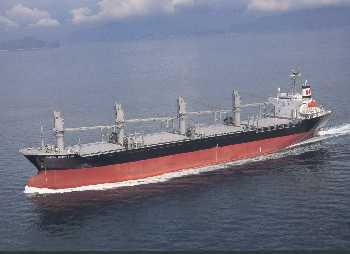 |
Santa Christina
25,378 dwt, blt 1996 by Imabari Shipbuilding, owned by Nissho Shipping (Tokyo) and on long time charter to Le Nickel SLN (Noum'a) Eramet Group |
|
Shipping and Shipbuilding Markets in 2001
I N D E X
|